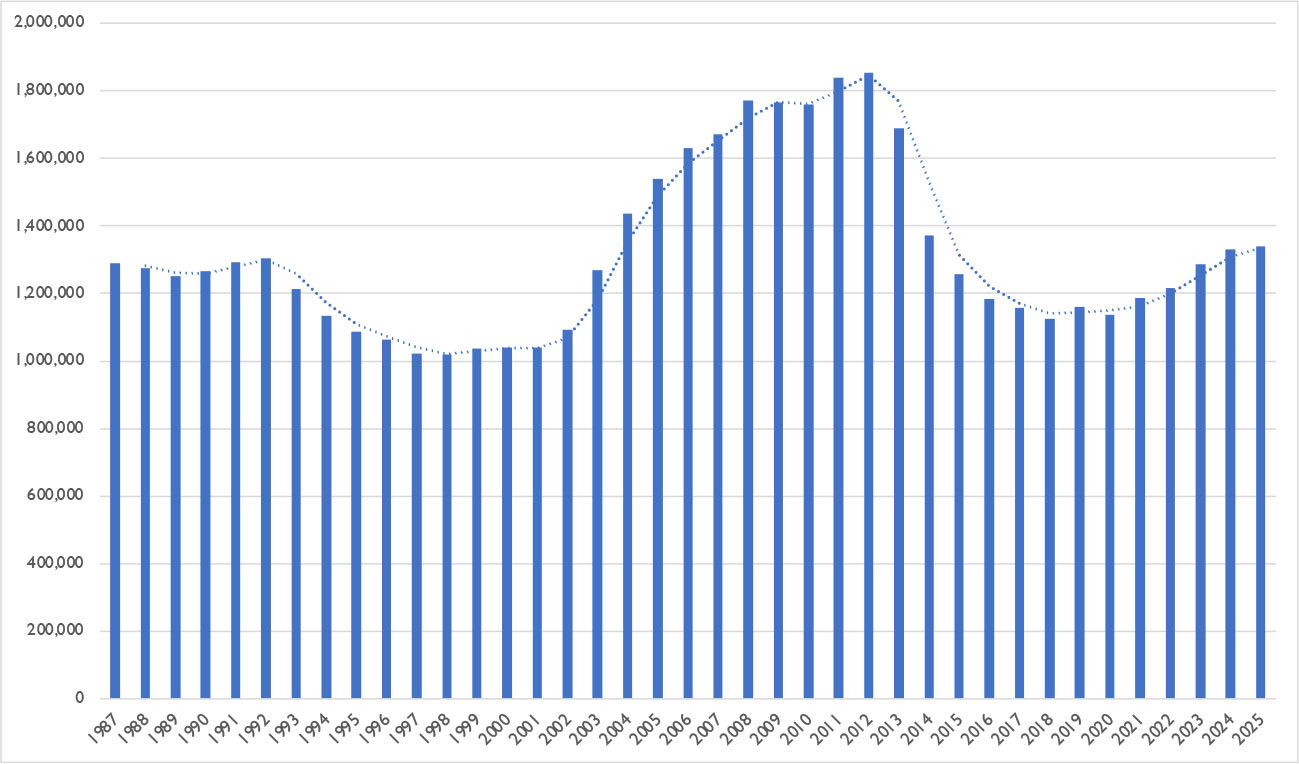Audience: government, registered providers
Subject: housing allocations
Geography: England

An ongoing increase in the housing waiting list numbers has slowed down, there’s lots of reasons as to why this might be, and it’s difficult to forecast the future trend.
1.3m households were on housing waiting lists throughout England at the 31 of March 2025, newly published data shows, which is -
- 1% higher compared to 2024, the previous year.
- 29% lower than2012, when numbers reached a record high.
- 24% higher than1998, when numbers reached a record low.
- 4% higher than1987, when number were first collected and published.
Number of households on local authority housing waiting lists, England, 1987 to 2025

The Ministry of Housing Communities & Local Government publishes statistics about English local authority housing waiting lists on an annual basis. This data is based on a snapshot taken in spring each year, with councils submitting the data returns during summer and the data being published during the autumn. There is no collection or publication of private registered providers housing waiting list statistics (not all private registered providers maintain housing waiting lists, as many hold common housing waiting lists with local authorities). All local authorities have to maintain a housing waiting list, regardless of whether they own social rented housing stock.
Housing waiting lists statistics were first collected and published in 1987, coinciding with the enactment of the Housing Act 1985, which established the current legal framework for allocating social rented housing. Over the next decade housing waiting list numbers reduced by one-fifth to a record low of 1m households in 1997.
Numbers started to increase again from 1998 onwards, coinciding with the enactment of the Housing Act 1996, resulting in substantial changes to housing allocation legislation, including new categories of people entitled to a reasonable preference for an allocation of social rented housing. Subsequently housing waiting-list numbers increased for the next 13 years, up 2012, nearly doubling to a record high of 1.8m households.
A reduction in housing waiting-list number from 2013 coincided with the enactment of the Localism Act 2011, which brought about changes to housing allocations legislation that allowed local authorities to set their own qualification criteria. Numbers reduced by 40% over a six-year period. Most local authorities made use of the power to disqualify households, with many allowing only households that are entitled to a reasonable preference for an allocation of social housing, and for those that local authorities have chosen to bestow an additional preference, to join a housing waiting list and excluding many other households. Other qualification criteria commonly used include a requirement to have a local connection, disallowing anyone guilty of unacceptable behaviour to join a housing allocation waiting list, disqualifying people who can afford to meet their housing needs from the commercial housing market, and amongst other factors.
An increase in the number of households on housing waiting lists occurred from 2020 onwards, with a slight dip the following year and then a steady rise over the next four years up to an including 2024. The most recent statistics shows that housing waiting list numbers have slowed down over the past 12 months. For the first time since housing waiting the statistics have been published, this change in trend did not coincide with the enactment of new housing allocation law.
However, the start of most recent increase coincided with local authorities gaining new duties to assist more people who are homeless or threatened with homelessness, at an early stage and over a longer period. Previous significant changes in trends on housing waiting list numbers have also coincided with the introduction of new homelessness duties. However, the record high number of households on housing waiting lists coincided with a near record low number of homeless households occupying temporary accommodation, whereas the previous and current record high levels of temporary accommodation, do not coincide with record high housing waiting list numbers, but do occur at times when housing waiting list numbers have been increasing. Therefore, is difficult to know what consequence changes to homelessness law has on housing waiting list numbers. The impact of new homelessness law on housing waiting list numbers compared to changes to housing allocations law, is unclear.
Housing waiting list statistics don’t reveal how many people were removed because they were allocated social rented housing, or any other reason (e.g. because a person no longer required social housing). Furthermore, there’s no data published on the number of people who apply to be included on a housing waiting list but are unsuccessful due to being ineligible or disqualified for an allocation of social rented housing. Therefore, there isn’t an entirely complete picture of housing waiting list trends.
The number of households on housing waiting list will be affected by broader social and economic factors and wider housing market supply and demand trends. However, the most significant influence on the housing waiting list numbers will be the number of social rented homes available to let, which has been decreasing over the past decade. The reasons for this varied but will be impacted by overall social rented housing stock levels, which are affected by the amount of existing social housing being disposed of and new social rented housing being built. Furthermore, eviction and tenancy sustainment rates also determine the amount of existing social rented housing being available to re-let.
It's open to question as to whether the number of households on housing waiting list will stand still, decrease or increase. Currently, there’s no intention to make changes to housing allocation or homelessness legislation in England, so there shouldn’t be any significant change in housing waiting list trends.

